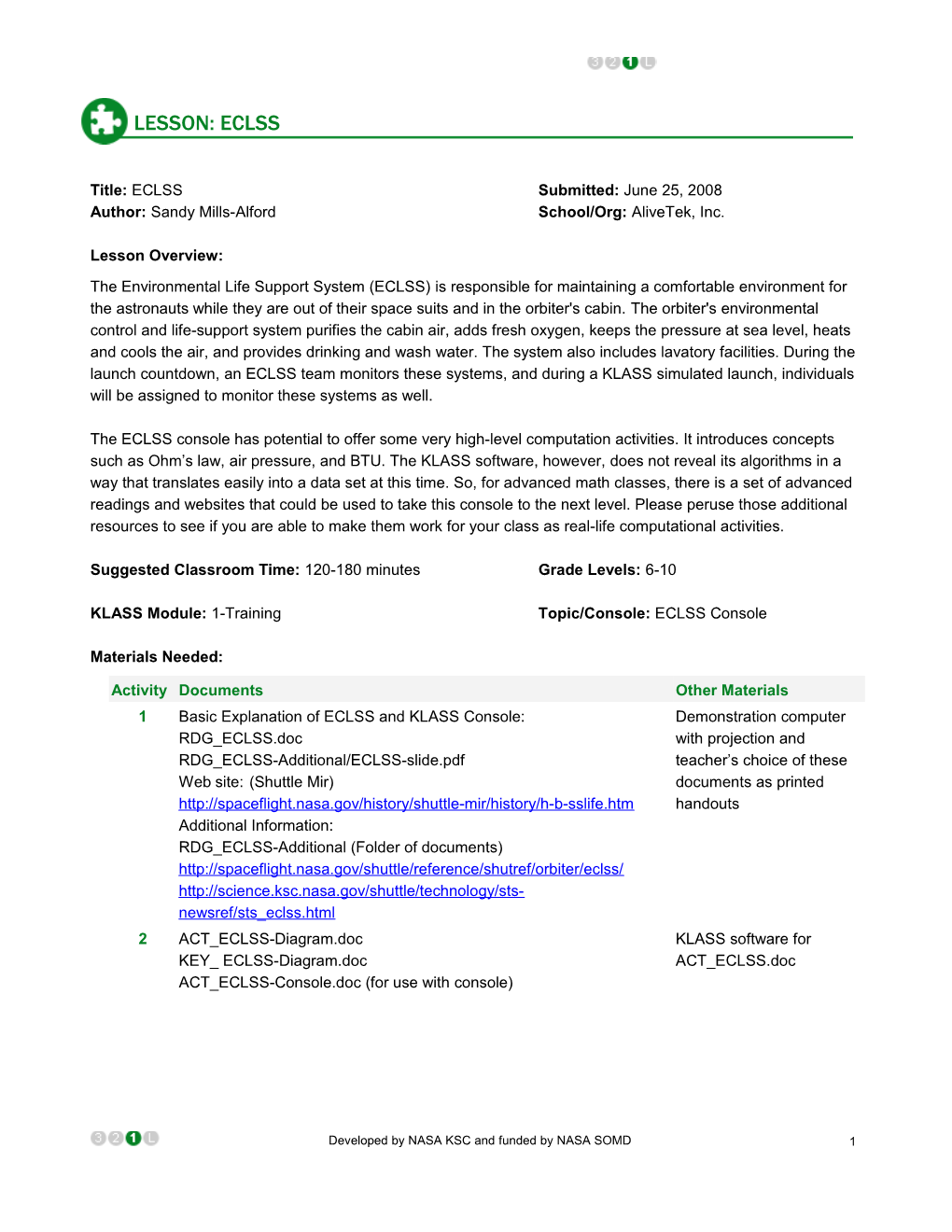LESSON: ECLSS
Title: ECLSS Submitted: June 25, 2008
Author: Sandy Mills-Alford School/Org: AliveTek, Inc.
Lesson Overview:
The Environmental Life Support System (ECLSS) is responsible for maintaining a comfortable environment for the astronauts while they are out of their space suits and in the orbiter's cabin. The orbiter's environmental control and life-support system purifies the cabin air, adds fresh oxygen, keeps the pressure at sea level, heats and cools the air, and provides drinking and wash water. The system also includes lavatory facilities. During the launch countdown, an ECLSS team monitors these systems, and during a KLASS simulated launch, individuals will be assigned to monitor these systems as well.
The ECLSS console has potential to offer some very high-level computation activities. It introduces concepts such as Ohm’s law, air pressure, and BTU. The KLASS software, however, does not reveal its algorithms in a way that translates easily into a data set at this time. So, for advanced math classes, there is a set of advanced readings and websites that could be used to take this console to the next level. Please peruse those additional resources to see if you are able to make them work for your class as real-life computational activities.
Suggested Classroom Time: 120-180 minutes Grade Levels: 6-10
KLASS Module: 1-Training Topic/Console: ECLSS Console
Materials Needed:
Activity / Documents / Other Materials1 / Basic Explanation of ECLSS and KLASS Console:
RDG_ECLSS.doc
RDG_ECLSS-Additional/ECLSS-slide.pdf
Web site: (Shuttle Mir)
http://spaceflight.nasa.gov/history/shuttle-mir/history/h-b-sslife.htm
Additional Information:
RDG_ECLSS-Additional (Folder of documents)
http://spaceflight.nasa.gov/shuttle/reference/shutref/orbiter/eclss/
http://science.ksc.nasa.gov/shuttle/technology/sts-newsref/sts_eclss.html / Demonstration computer with projection and teacher’s choice of these documents as printed handouts
2 / ACT_ECLSS-Diagram.doc
KEY_ ECLSS-Diagram.doc
ACT_ECLSS-Console.doc (for use with console) / KLASS software for ACT_ECLSS.doc
National Standards/Objectives:
Science / F. Science in Personal and Social Perspectives / Students understand the risks, benefits, and importance of environmental quality.
Technology / Technology problem-solving and decision-making tools / Students use technology resources for solving problems and making informed decisions.
Math / Representation / Students create and use representations to organize, record, and communicate mathematical ideas.
Desired Results:
Students will be able to answer these essential questions
· How does the orbiter’s ECLSS work?
· What will I need to know as a member of the Shuttle launch team that monitors and controls the orbiter’s environmental control and life-support systems with KLASS?
· How can I contribute to a larger group within a complex operation such as the orbiter’s ECLSS?
Students will know
· The basic responsibilities of the ECLSS KLASS engineers.
· How to record a sequence of ECLSS data from the KLASS console.
· The four subsystems of the orbiter’s ECLSS and the basic locations of the 23 individual components.
Students will be able to
· Record accurate observations while observing a variety of data feeds by the KLASS ECLSS consoles.
· Assimilate into the role of ECLSS engineer by monitoring, correcting, and communicating data to the larger launch team.
Learning Plan/Activities:
1. Introducing the Lesson.
Review the appropriate documents (depending on the age/grade/level of your group) and help students understand what the orbiter’s Environmental Control and Life-Support System (ECLSS) does. There is a basic ECLSS reading document (RDG_ECLSS.doc) and an overview slide (RDG_ECLSS-Additional/ECLSS-slide.pdf) available for a class demonstration and discussion. Visit any websites with your class you believe are appropriate to help them better understand this highly complicated but important system.
2. Observing, Labeling, and Recording.
Based on the ECLSS reading document (RDG_ECLSS.doc), have the students label the ECLSS diagrams. Next, have the students start the ECLSS console and get used to reading and recording the data. A worksheet has been provided for this purpose. Depending on how much you would like them to record, you may want to adjust the worksheet. Note that there are 2 different data sets requested on each of the two pages.
3. Evaluating the Lesson.
During the above activities, students should be making the connection between the real orbiter ECLSS and the KLASS ECLSS. Follow up this activity by reinforcing the key roles that will be needed for the KLASS simulation. Revisit the KLASS_Shuttle-Launch-Team-Roles handout, paying attention to the ECLSS description of responsibilities.
Assessment Evidence:
Performance Tasks
1. Students will be able to piece together the orbiter’s ECLSS by completing the activities, but they do not need to completely understand what each component means.
2. Students should begin to understand the function of the ECLSS KLASS module and the data that is referenced and used during the simulation.
Extensions and Going Further Resources:
· Science in a Box. As the discussion regarding environmental support for the astronauts unfolds, it also may be emphasized that it is important to manage the environment for the payload, equipment, and science labs that are on board. Included in the RDG_ECLSS-Additional folder is a Science in a Box resource that includes directions for building and performing experiments in a glove box.It would be a great resource for those instructors wanting to do hands-on experiments like NASA.
· There is a cute tutorial on How Stuff Works titled, How does going to the bathroom in space work? http://science.howstuffworks.com/bathroom-in-space.htm. This could be a fun introductory activity. Also, there is a video on the same page that discusses the challenges of living in space, which does relate to ECLSS.
· Be sure to check for student opportunities, additional educational resources and more at:
http://www.nasa.gov/education
